e. Plan and Integrate Obstacles. The following steps apply in planning and integrating obstacles in the company defense (Figure 5-18, page 5-36): (1) Understand obstacle group intent.
(2) Coordinate with the engineers.
(3) Site and mark individual obstacle locations.
(4) Refine direct and indirect fire control measures.
(5) Identify lanes and gaps.
(6) Report obstacle locations and gaps to higher headquarters.
5-35
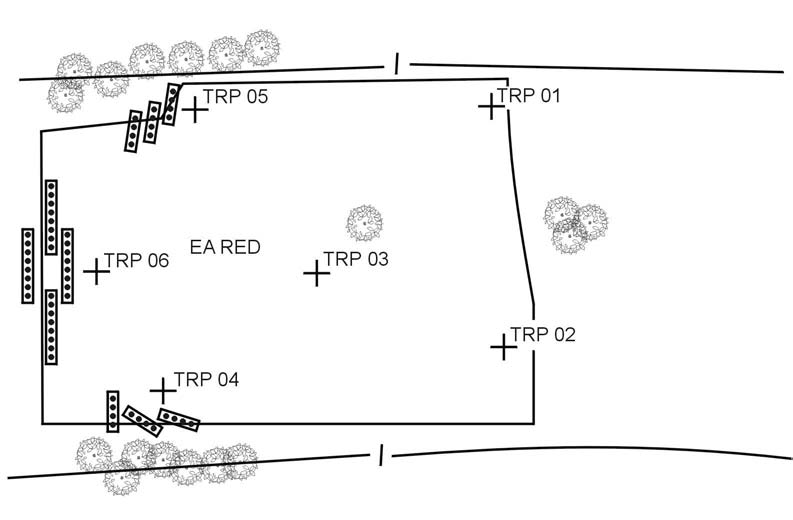
FM 3-21.11
Figure 5-18. Plan and integrate obstacles.
f. Plan and Integrate Indirect Fires. The following steps apply in planning and integrating indirect fires (Figure 5-19):
(1) Determine the purpose of fires and the essential fire support task (EFST) that supports it.
(2) Determine where the purpose can best be achieved.
(3) Establish the observation plan, with redundancy for each target. Observers include the FIST, as well as members of maneuver elements with fire support responsibilities (such as platoon sergeants).
(4) Establish triggers.
(5) Obtain accurate target locations using lasing devices.
(6) Refine target locations to ensure coverage of obstacles.
(7) Adjust artillery and mortar targets.
(8) Plan FPFs.
(9) Request critical friendly zones (CFZs) for protection of maneuver elements and no-fire areas (NFAs) for protection of OPs and forward positions.
5-36
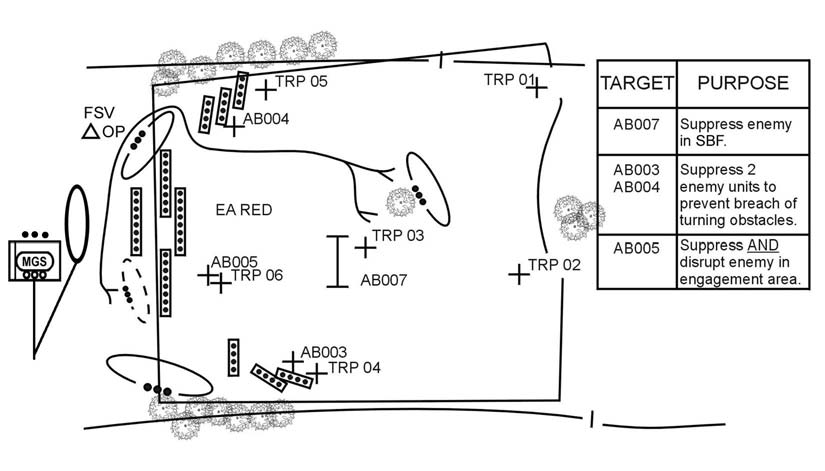
FM 3-21.11
Figure 5-19. Integrate direct and indirect fires.
g. Conduct an Engagement Area Rehearsal. The purpose of this rehearsal is to ensure every leader and soldier understands the plan and all elements are prepared to cover their assigned areas with direct and indirect fires. Although the company commander has several options, the most common and most effective type of rehearsal is to replicate the threat. One technique for the rehearsal in the defense is to have the company trains, under the control of the company XO, move through the EA to depict the enemy force while the commander and subordinate platoons rehearse the battle from the company BP. The rehearsal should cover these actions:
• Rearward passage of security forces (as required).
• Closure of lanes (as required).
• Movement from the hide position to the BP.
• Use of fire commands, triggers, and maximum engagement lines (MELs) to initiate direct and indirect fires.
• Shifting of fires to refocus and redistribute fire effects.
• Emplacement of scatterable mine systems.
• Preparation and transmission of critical reports using frequency modulated (FM) and digital systems (as applicable).
• Assessment of the effects of enemy weapons systems.
• Displacement to alternate, supplementary, or subsequent BPs.
• Cross-leveling or resupply of Class V.
• Evacuation of casualties.
NOTE: The company commander should coordinate the rehearsal with the battalion to ensure other units’ rehearsals are not planned for the same time or location.
Coordination leads to more efficient use of planning and preparation time for all battalion units. It also eliminates the danger of misidentification of friendly forces in the rehearsal area, which could result in fratricide.
5-37
FM 3-21.11
5-28. PRIORITY OF WORK
Priority of work is a set method of controlling the preparation and conduct of a defense.
SOP should describe priority of work to include individual duties. The commander changes priorities based on the situation. All leaders in the company should have a specific priority of work for their duty position.
a. Although listed in sequence, several tasks may be performed at the same time. An example priority of work sequence is as follows:
• Establish the company R&S operation.
• Post local security.
• Position Javelins, MGS vehicles, machine guns, and soldiers; assign sectors of fire.
• Position other assets (company CP, mortars, and vehicles).
• Designate FPLs and FPFs.
• Clear fields of fire and prepare range cards and sector sketches.
• Adjust indirect fire FPFs. The firing unit FDC should provide a safety box that is clear of all friendly units before firing any adjusting rounds.
• Prepare fighting positions.
• Install wire communications, if applicable.
• Emplace obstacles and mines.
• Mark (or improve marking) for TRPs and direct fire control measures.
• Improve primary fighting positions such as overhead cover.
• Prepare alternate and supplementary positions.
• Establish sleep/rest plan.
• Reconnoiter movements.
• Rehearse engagements and disengagements or displacements.
• Adjust positions and control measures as required.
• Stockpile ammunition, food, and water.
• Dig trenches between positions.
• Reconnoiter routes.
• Continue to improve positions.
b. Routine priorities for various duty positions are listed below.
(1) Company Commander. Many of these duties can be delegated to subordinates, but the commander must ensure they are done. The commander must--
• Establish local security. Set up OPs if not already done and establish an SBCT
infantry company perimeter.
• Conduct a leader's reconnaissance with the platoon leaders and selected personnel. Confirm or deny significant deductions or assumptions from the mission analysis. Designate primary, alternate, and supplementary positions for platoons, sections, and supporting elements. Require platoons to conduct coordination. Designate EAs, designate and integrate obstacles, designate the general company CP location, and position key weapons.
• Check the company CP and brief the 1SG and XO on the situation and logistics requirements.
5-38
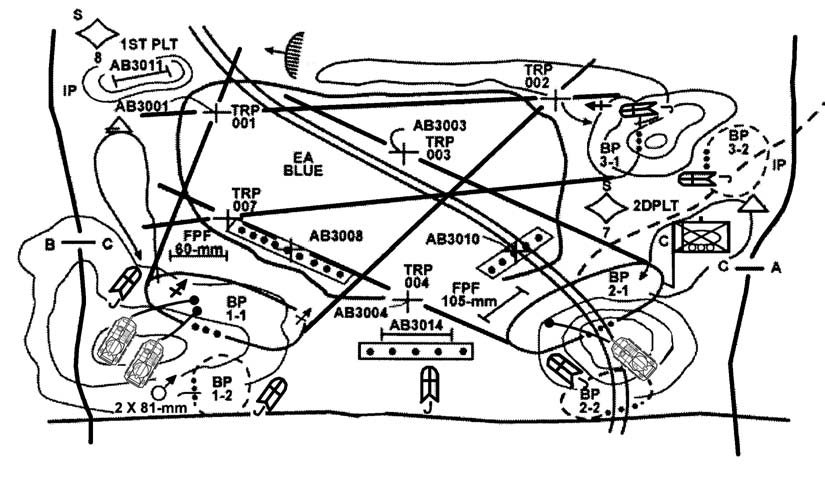
FM 3-21.11
• Upon receipt of the platoon sector sketches, make two copies of a defensive sector sketch and a fire plan. Retain one copy and forward the other to the battalion (Figure 5-20). Ideally, this is accomplished through FBCB2.
• Confirm the platoon positions before digging starts. Coordinate with the left and right units.
• Check with the battalion commander for any changes or updates in the orders.
• Finish the security, deception, counterattack, and obstacle plans.
• Walk the company positions after they are dug. Confirm clear fields of fire and complete coverage of the sector of fire of all key weapons. Look at the defensive plan from an enemy point of view, both conceptually and
physically.
• Check dissemination of information, interlocking fires, dead space, and security.
• Correct deficiencies immediately.
• Report obstacle locations.
Figure 5-20. Company defensive sector sketch.
(2) First Sergeant and Executive Officer. One of them must--
• Establish the company CP and ensure that wire communications link the platoons, sections, and attached elements if applicable.
• Establish casualty collection points, company logistics release points, and EPW collection points.
• Brief platoon sergeants on the company CP location, logistics plan, and routes between positions.
• Assist the company commander with the sector sketch.
• Request and allocate pioneer tools, barrier material, rations, water, and ammunition.
5-39
FM 3-21.11
• Walk the positions with the company commander. Start supervising emplacement of the platoons and sections, and check range cards and sector sketches.
• Establish routine security or alert plan, radio watch, and rest plan. Brief the company commander.
• Supervise continuously and assist the commander with other duties as assigned.
(3) Fire Support Officer. The FSO must--
• Assist the commander in planning the indirect fires to support the defense.
• Advise the commander on the current status of all firing units and on the use of smoke or illumination.
• Coordinate with the SBCT infantry battalion FSO, firing units, and platoon leaders to ensure the fire plan is synchronized and fully understood.
• Ensure the indirect fire plan is rehearsed and understood by all.
• Ensure all FPFs are adjusted in as soon as possible.
• Develop observation plan.
• Coordinate and rehearse any repositioning of observers within the company sector to ensure they can observe targets or areas of responsibility.
• Develop triggers.
• Report battlefield intelligence.
• Ensure redundancy in communications.
(4) Mortar Section Leader. He must--
• Choose tentative firing position(s) and OP(s) and complete his portion of the fire plan based on the company OPORD, coordinated with the FSO and his own analysis.
• Take part in the company leader's reconnaissance. Confirm or adjust the firing position, select OPs, and coordinate the indirect fire plan with the company FSO.
• Issue FRAGOs to the mortar squads. Conduct a section leader's
reconnaissance with squad leaders. Require squad leaders to coordinate with platoons and squads for security and logistics support.
• Direct the mortar section to begin digging.
• Establish internal and external wire communications, if applicable.
• Assist the FSO in completing the fire plan and overlays.
• Register and adjust the FPF.
• Inspect the mortar position.
• Reconnoiter routes to alternate firing positions.
(5)
Communications Specialist. He must--
• Supervise setting up wire, radio, voice, and digital communications with the battalion, platoons, and sections.
• Organize a radio watch.
• Supervise the performance of preventive maintenance checks and services (PMCS) on the radios.
• Assist the 1SG and XO, as required. Help organize local security for the company CP, dig fighting positions, and assist in OPORD production.
5-40
FM 3-21.11
(6) NBC NCO. He must--
• Assist the commander with an updated MOPP analysis.
• Ensure that chemical detection and monitoring procedures are established and maintained.
• Coordinate for decontamination support.
• Coordinate smoke support.
• Supervise decontamination operations.
• Provide guidance on operations in NBC conditions.
5-29. ADJACENT
UNIT
COORDINATION
The ultimate goal of adjacent unit coordination is to ensure unity of effort in the accomplishment of the SBCT's and SBCT infantry battalion's missions. Items that adjacent units must coordinate include, but are not limited to, the following:
• Unit positions, including locations of command and control nodes.
• Locations of OPs and patrols.
• Overlapping fires (to ensure that direct fire responsibility is clearly defined).
• TRPs.
• Alternate, supplementary, and subsequent BPs.
• Indirect fire and encryption information.
• Obstacles (location and type).
• Air defense considerations, if applicable.
• Routes to be used during occupation and repositioning.
• CSS considerations.
Section VI. RETROGRADE OPERATIONS
The retrograde is a type of defensive operation that involves organized movement away from the enemy (FM 3-0). The enemy may force these operations or a commander may execute them voluntarily. In either case, the higher commander of the force executing the operation must approve the retrograde (FM 3-90). Retrograde operations are conducted to improve a tactical situation or to prevent a worse situation from developing. Companies normally conduct retrogrades as part of a larger force but may conduct independent retrogrades (withdrawal) as required, such as when conducting a raid. Retrograde operations accomplish the following:
• Resist, exhaust, and defeat enemy forces.
• Draw the enemy into an unfavorable situation.
• Avoid contact in undesirable conditions.
• Gain time.
• Disengage a force from battle for use elsewhere in other missions.
• Reposition forces, shorten lines of communication, or conform to movements of other friendly units.
• Secure more favorable terrain.
There are three types of retrograde operations:
• Delay. This operation allows the unit to trade space for time, avoiding decisive engagement and safeguarding its elements.
5-41
FM 3-21.11
• Withdrawal. The commander uses this operation to break enemy contact, especially when he needs to free the unit for a new mission.
• Retirement. This operation is employed to move a force that is not in contact to the rear.
5-30. DELAY
A delay is a series of defensive and offensive actions over subsequent positions in depth.
It is an economy of force operation that trades space for time. While the enemy gains access to the area (space) that is vacated, friendly elements gain time to conduct necessary operations and retain freedom of action and maneuver. This allows friendly forces to influence the action; they can prevent decisive engagement or postpone action to occur at a more critical time or place on the battlefield.
a. Types of Delays. There are two types of delay missions:
• Delay in sector.
• Delay forward of a specified line or position for a specified time.
b.
Components of Successful Delay. For either type of delay mission, the flow of the operation can be summarized as “hit hard, then move.” A successful delay has three key components:
• The ability to stop or slow the enemy’s momentum while avoiding decisive engagement.
• The ability to degrade the enemy’s combat power.
• The ability to maintain a mobility advantage.
c. Delay within a Sector. The company may be assigned a mission to delay within a sector (area of operations). The higher commander normally provides guidance regarding intent and desired effect on the enemy, but he minimizes restrictions regarding terrain, time, and coordination with adjacent forces. This form of a delay is normally assigned when force preservation is the highest priority and there is considerable depth to the battalion or SBCT’s area of operations.
d.
Delay Forward of a Specified Line for a Specified Time. The company may be assigned a mission to delay forward of a specific control measure for a specific period of time. This mission is assigned when the SBCT or battalion must control the enemy’s attack and retain specified terrain to achieve some purpose relative to another element, such as setting the conditions for a counterattack, for completion of defensive preparations, or for the movement of other forces or civilians. The focus of this delay mission is clearly on time, terrain, and enemy destruction. It carries a much higher risk for the battalion, with the likelihood of all or part of the unit becoming decisively engaged. The timing of the operation is controlled graphically by a series of phase lines with associated dates and times to define the desired delay-until period.
e. Culmination of the Delay. Delay missions usually conclude in one of three ways--a defense, a withdrawal, or a counterattack. Planning options should address all three possibilities.
5-31. PLANNING
In preparing for the delay operation, the commander uses planning considerations that are identical to those for a defense in sector, varying only in their purpose. Planning for the 5-42
FM 3-21.11
delay must cover several areas related to hindering enemy movement and maintaining mobility. These considerations include the following:
• Use of existing terrain and obstacles, enhanced as necessary by employment of reinforcing obstacles.
• Designation of positions from which the friendly force can harass or impede the enemy without risking decisive engagement itself; this is especially applicable for a delay in sector. When a battalion is delaying in sector, companies are normally assigned a series of specific BPs to enhance command and control across the sector. Likewise, in a company delay in sector, the commander will assign a series of specific BPs for each platoon.
• Assessment of opportunities to conduct limited counterattacks to disrupt enemy actions.
• Designation of high-speed avenues of withdrawal.
• Rehearsal of operations anticipated for the delay; these may include engagement of the enemy and maneuver through the delay area.
5-32. DELAY
TECHNIQUES
In executing either a delay in sector or a time-related delay, the commander can choose from the following techniques:
• Delay from subsequent positions or phase lines.
• Delay from alternating positions.
a. Delay from Subsequent Positions or Phase Lines. This delay technique normally is used when the sector is so wide that available forces cannot occupy more than a single line of positions.
(1) The commander must be aware of several factors that may put his unit at a disadvantage during the delay:
• Lack of depth at any particular time.
• The possibility of inadequate time to prepare subsequent positions.
• Decreased security during disengagement.
• The possibility of gaps between units.
(2) When the unit receives the order to conduct the delay from its initial positions, one element (such as a company in a battalion delay or a platoon in a company delay) displaces and occupies its subsequent BP. The remainder of the unit maintains contact with the enemy until the first displacing element is in position to engage the enemy from the subsequent position. The first element then provides overwatch or base of fire as other elements displace to their subsequent positions. Figure 5-21, page 5-44, illustrates a company conducting a dismounted delay from subsequent positions.
5-43
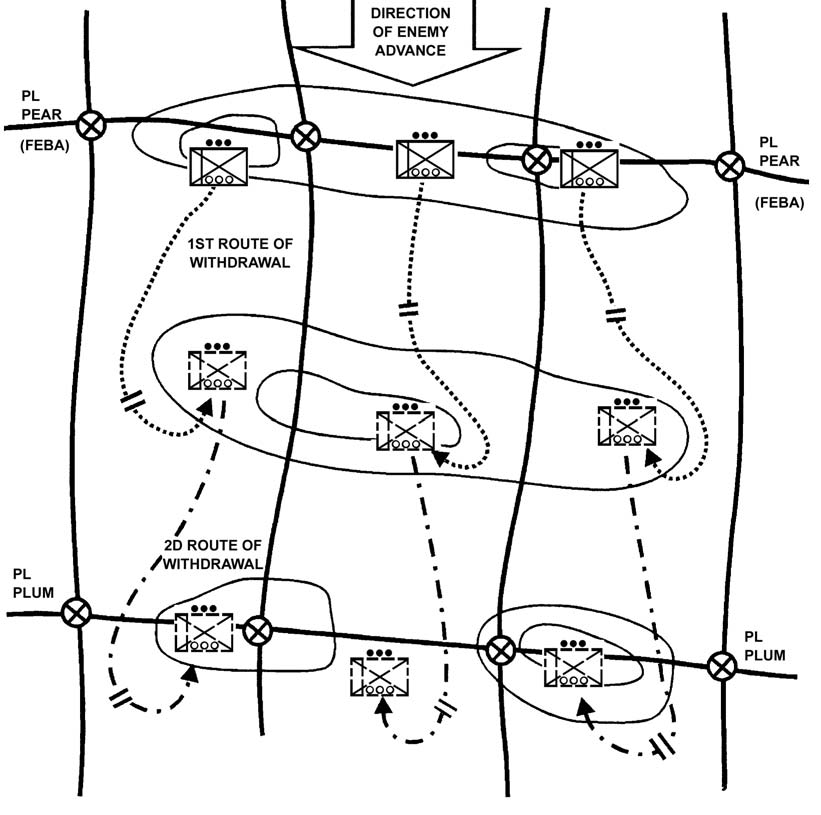
FM 3-21.11
Figure 5-21. Example company dismounted delay from subsequent
positions.
b. Delay from Alternating Positions. This method of delay may be used when the delaying element has sufficient forces to occupy more than a single line of positions (normally in a narrow sector). The delaying battalion or company arrays one or more of its subordinate elements in the initial delay positions. This first echelon then engages the enemy while the rest of the unit occupies and prepares second-echelon delay positions.
(1) The unit then alternates fighting the enemy with movement to new positions. The elements in the initial delay positions engage the enemy until ordered to displace or until their displacement criteria have been met. They then displace, moving through the second-echelon delay positions to their own subsequent positions (which become the third echelon of the delay).
(2) Elements in the second echelon overwatch the displacing units’ movement and assume responsibility for engaging the enemy. This sequence continues until the delay operation is completed. Figure 5-22 illustrates a company delay from alternating positions.
5-44
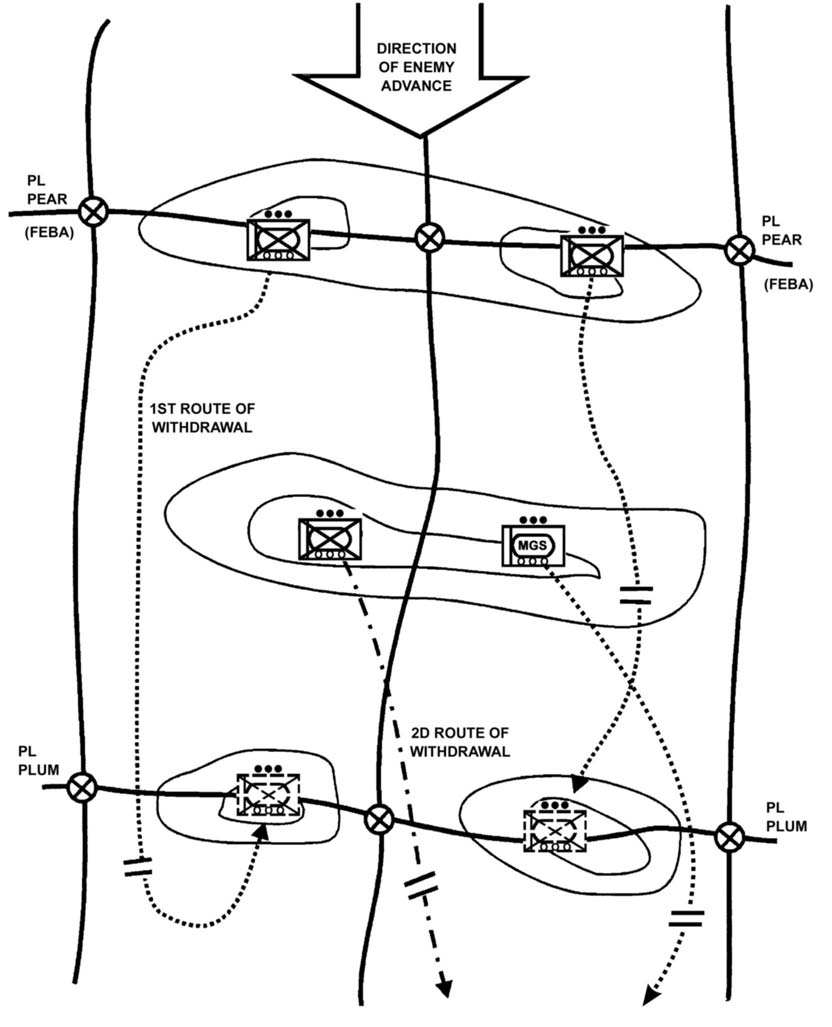
FM 3-21.11
Figure 5-22. Example company delay from alternating positions.
5-33. WITHDRAWAL
Withdrawal is a planned operation in which a force in contact disengages from an enemy force. Withdrawals may or may not be conducted under enemy pressure. The two types of withdrawals are assisted and unassisted.
a.
Assisted. The assisting force occupies positions to the rear of the withdrawing unit and prepares to accept control of the situation. It can also assist the withdrawing unit with route reconnaissance, route maintenance, fire support, and CSS. Both forces closely
5-45
FM 3-21.11
coordinate the withdrawal. After coordination, the withdrawing unit delays to a battle handover line, conducts a passage of lines, and moves to its final destination.
b.
Unassisted. The withdrawing unit establishes routes and develops plans for the withdrawal and then establishes a security force as the rear guard while the main body withdraws. CSS and CS elements normally withdraw first followed by combat forces. To deceive the enemy as to the friendly movement, the SBCT or battalion may establish a detachment left in contact (DLIC) if withdrawing under enemy pressure. As the unit withdraws, the DLIC disengages from the enemy and follows the main body to its final destination.
5-34. PHASES
Withdrawals are accomplished in three overlapping phases, which are outlined in the following paragraphs.
a.
Preparation. The commander dispatches quartering parties, issues warning orders (WARNOs), and initiates planning. Nonessential vehicles are moved to the rear.
b. Disengagement. Designated elements begin movement to the rear. They break contact and conduct tactical movement to a designated assembly area or position.
c. Security. In this phase, a security force protects and assists the other elements as they disengage and or move to their new positions. This is done either by a DLIC, which the unit itself designates in an unassisted withdrawal, or by a security force provided by the higher headquarters in an assisted withdrawal. As necessary, the security force assumes responsibility for the sector, deceives the enemy, and protects the movement of disengaged elements by providing overwatch and suppressive fires. In an assisted withdrawal, the security phase ends when the security force has assumed responsibility for the fight and the withdrawing element has completed its movement. In an unassisted withdrawal, this phase ends when the DLIC completes its disengagement and movement to the rear.
5-35. UNASSISTED
WITHDRAWAL
In an unassisted withdrawal, the unit conducting the withdrawal establishes the DLIC to maintain contact with the enemy and or to deceive him.
a. Battalion Withdrawal. In a battalion withdrawal, the DLIC may consist of an element from each company (under leadership of the company XO or a platoon leader), with the battalion S3 as the overall DLIC commander. As an alternative, a company may serve as the DLIC for the rest of the battalion. The company commander has several deployment options. He can reposition elements across the entire battalion frontage.
Another option is to position the company to cover only the most dangerous enemy avenue of approach; other avenues into the sector are covered with observation from additional security elements provided by the battalion, such as the reconnaissance platoon.
b. Company Unassisted Withdrawal. The commander has similar options in an unassisted company withdrawal. He may designate one platoon to execute the DLIC
mission for the company, or he can constitute the DLIC using elements from the three rifle platoons and the MGS platoon, with the XO as the DLIC commander. Figure 5-23
illustrates an example of an unassisted withdrawal.
5-46
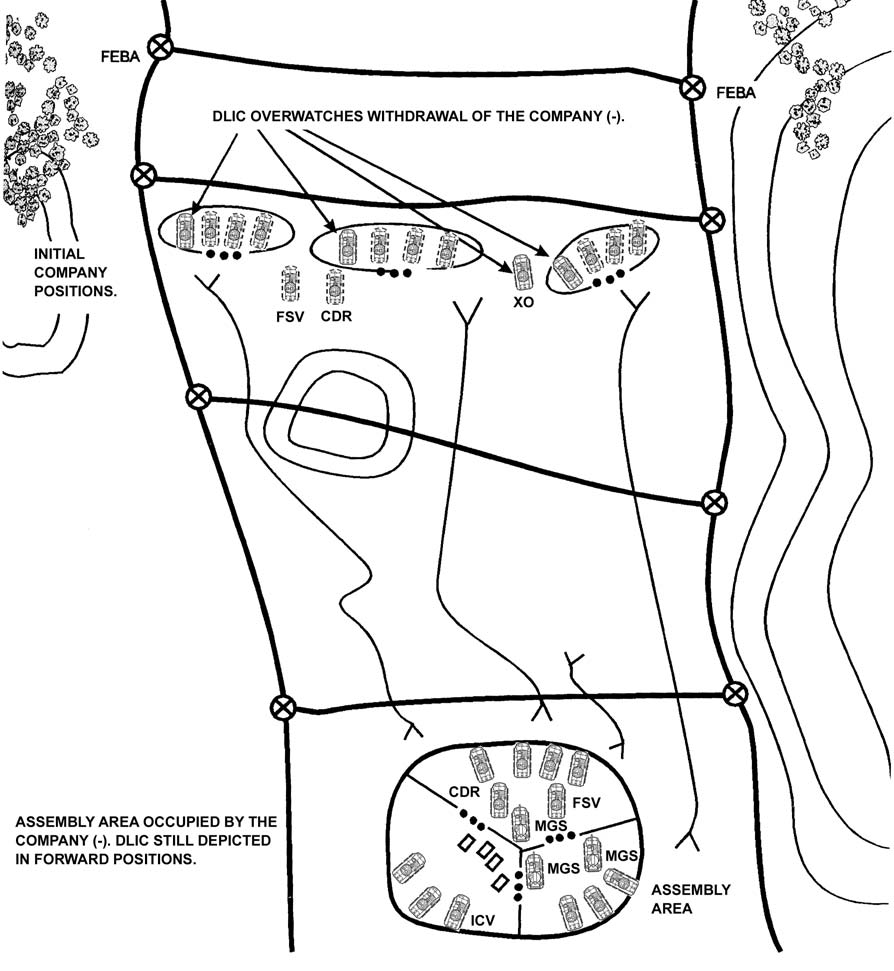
FM 3-21.11
Figure 5-23. Example of an unassisted withdrawal.
5-36. ASSISTED
WTHDRAWAL
In an assisted battalio









